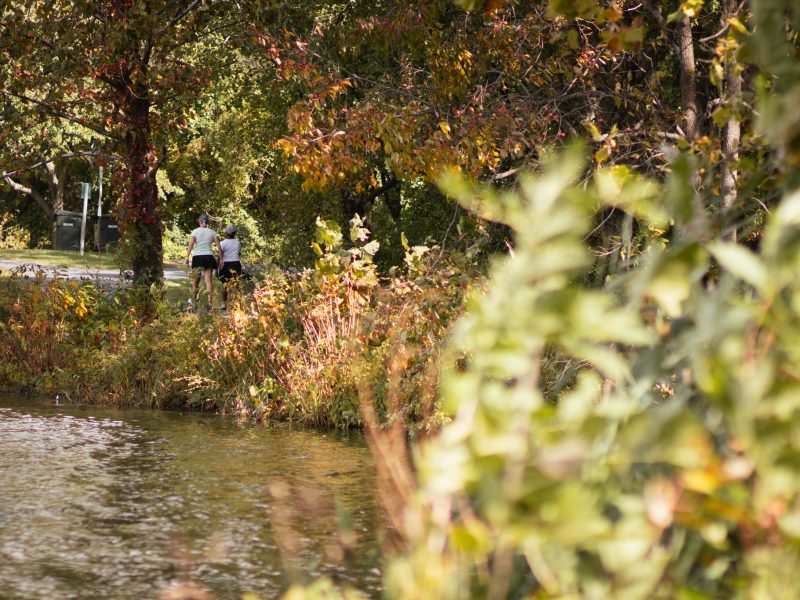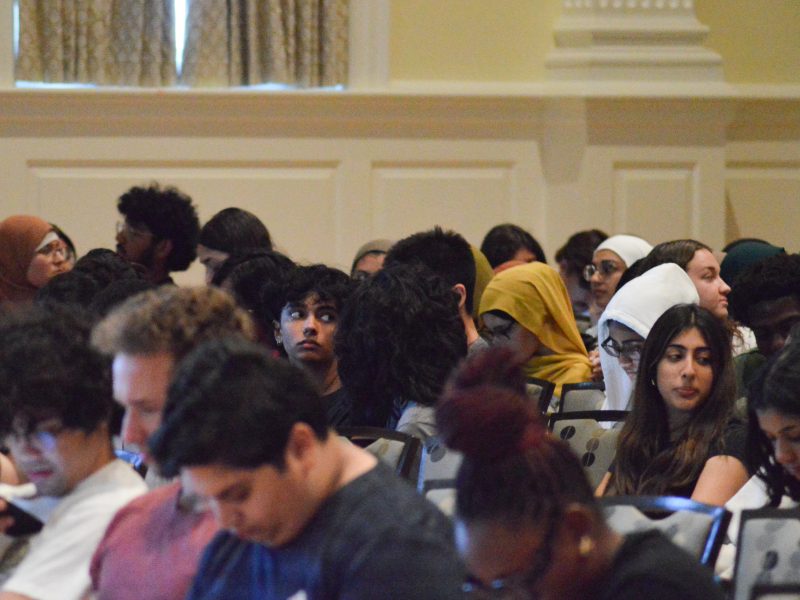By Fatemeh Paryavi
For The Diamondback
University of Maryland students who stream past the statue of Frederick Douglass in Hornbake Plaza each day might think it’s a simple homage to the famous abolitionist and Maryland native.
But the statue holds far more meaning, said Kim Nickerson, the assistant dean of diversity and inclusion of the behavioral and social sciences college.
“The university hasn’t gotten around [to] creating a plaque to describe the features to the public, but I’ll do it for you,” Nickerson said during the tour.
The artist replicated Douglass’ outstretched arm from a photo of former President Barack Obama, Nickerson said. The long coat represents a similar one worn by former President Abraham Lincoln.
The abolitionist’s coat billows out behind him and his mouth is wide as if he is shouting into the winds of oppression, Nickerson added.
[Read more: A UMD black history tour will launch online this month, but the SGA has plans for its own]
The statue was the final stop on one of the Office of Multicultural Involvement and Community Advocacy’s four Black History Month tours throughout February. It touched on notable black history landmarks across this campus.
Senior criminal justice major Marlon Taffe said the tour was eye-opening to some parts of this university’s history that aren’t well known.
Taffe was one of about 10 students, faculty and staff who trekked around campus Feb. 15. The tour began on the steps of the Rossborough Inn, the oldest landmark at this university, which Nickerson said was thought to have housed slaves at one time. They may have helped build the university when it was called Maryland Agricultural College.
Plantation owner and Maryland politician Charles Benedict Calvert used to own the Rossborough Inn, which was built at the turn of the 18th century, Nickerson said.
“History is not the past, it is the present,” he said, quoting the civil rights activist James Baldwin. “We carry our history with us. We are our history.”
Over the last six years, MICA has expanded its celebration of Black History Month to include art exhibits and expert panels on race. Last year, this university’s Office of Diversity and Inclusion commissioned a virtual tour of all the landmarks related to black history on campus.
The tour group stopped at a bench in the Memorial Chapel garden that faces southeast — toward Africa. They later stopped at the Shoemaker Building, which features a room dedicated to Thurgood Marshall, the first African-American justice to serve on the Supreme Court of the United States.
According to the story, Marshall was upset when Donald Gaines Murray — who would go on to become the first African-American to be admitted to the University of Maryland law school — was rejected from this university. Marshall walked up the steps of the Shoemaker Building demanding to know why the man was rejected, and a room was later dedicated to him.
Nickerson said the landmarks were chosen to “inspire and motivate” students, helping them realize they can achieve great things in college by seeing the accomplishments of those who have come before them.
Taffe said he initially attended the tour to earn class credit but left feeling inspired by Nickerson’s words and the various landmarks they visited.
“Like [Nickerson] was saying before, anyone can kind of make it here,” he said. “You should feel proud to be here and that you can make it.”
Derrick Peoples, a compensation analyst in the university’s human resources department, said that he was “excited to see some of the footprints where our forefathers walked and made on campus.”
I didn’t know we had such an impact on this campus,” said Peoples.
The tour was much needed “to honor the contribution and legacy [black] Americans had and still have on this campus and the country,” he said.
Derek Bowe, an academic adviser in the business school, said the tour inspired him and made him realize there is still work to be done in advocating for equality.
“That’s where the inspiration comes in — to continue to advocate,” he said.
Bowe and Taffe said more people should know about the campus tour.
“We were walking through and we were saying a lot of these things people just walk by and don’t really notice,” Taffe said of the landmarks. “I feel like we should really know what’s behind the makeup of our university.”



